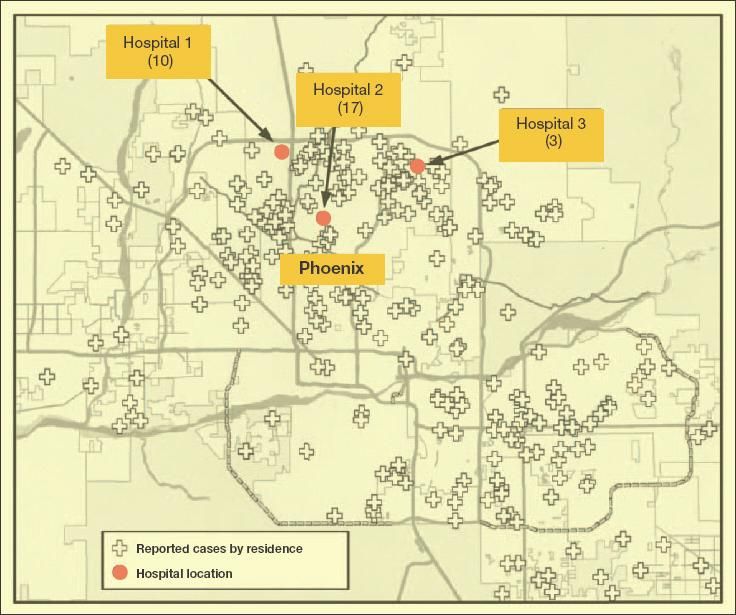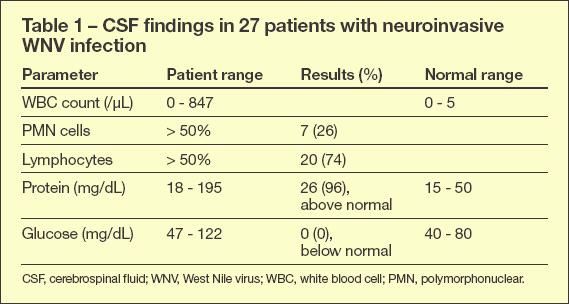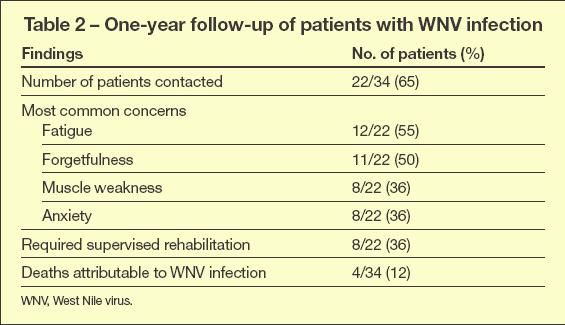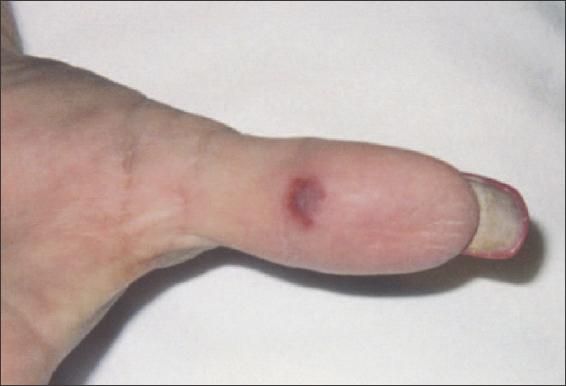- Clinical Technology
- Adult Immunization
- Hepatology
- Pediatric Immunization
- Screening
- Psychiatry
- Allergy
- Women's Health
- Cardiology
- Pediatrics
- Dermatology
- Endocrinology
- Pain Management
- Gastroenterology
- Infectious Disease
- Obesity Medicine
- Rheumatology
- Nephrology
- Neurology
- Pulmonology
Clinical Observations on West Nile Virus Infections
In 2004, 391 cases of West Nile virus (WNV) infection werereported in Arizona. This represented an epidemic thatchallenged area clinicians. We treated 34 patients with WNVinfection and reviewed their medical records. They werehospitalized at 3 community hospitals during the epidemic.These patients represented 9% of all WNV infection casesreported in Arizona. Meningitis was diagnosed in 13 patients,encephalitis in 12, fever of unknown origin in 5, transversemyelitis in 3, and carditis in 1. Respiratory failure requiringmechanical ventilation developed in 6 patients. Five of thesickest patients were empirically treated with interferon alfa 2band ribavirin. The epidemic and associated clinical challengesprompted evaluation of the available diagnostic and treatmentstrategies to optimize care of very ill patients. The consensusamong clinicians was that they were poorly prepared todiagnose and treat WNV infection in hospitalized patients.All patients survived hospitalization, although 4 patientsdied after discharge because of factors attributable to WNVinfection. [Infect Med. 2008;25:430-434]
West Nile virus (WNV) is a mosquito-borne virus that first appeared in North America in New York City in 1999.1 Since then, the virus has spread across the United States, causing disease in virtually every state. Arizona experienced its first cases-15 total-in 2003. In 2004, the number of proven cases increased to 391 (Craig Levy, personal communication, from the Arizona Department of Health Services, Vector-Borne and Zoonotic Diseases Program, October 4, 2005). The more than 25-fold increase in cases in 2004 was unexpected, given the hot and dry climate of Phoenix where the majority of cases occurred. We report on 34 cases that were treated in 3 community hospitals. About 68% (265 of 391) of cases of WNV infection seen in Arizona in 2004 were clustered around these 3 hospitals in metropolitan Phoenix (Figure 1).

Figure 1 -
The map shows the relationship between the hospital location of 34 patients with West Nile virus (WNV) infection and the reported cases of WNV infection by residence.
Clinical observations
All 34 patients were initially seen in the emergency department, and all but 1 were admitted to the hospital after evaluation. After admittance, the patients were evaluated by a hospitalist. The hospitalist, in turn, made a request for an infectious disease consultation.
All cases of WNV infection were confirmed serologically. A test for WNV-specific IgG and IgM in serum and a WNV IgM antibody-capture enzyme immunoassay (EIA) of cerebrospinal fluid (CSF) were performed. Antibody-capture EIA was also used to detect St Louis encephalitis virus-specific IgM antibodies in CSF. Testing for herpes simplex virus (HSV) antigen by polymerase chain reaction was performed on CSF for all cases of neuroinvasive disease. All test results for St Louis encephalitis and HSV infection were negative.
The charts of 34 patients with confirmed WNV infection were reviewed and a consensus clinical diagnosis was made. There were 13 cases (38%) of meningitis and 12 cases (35%) of encephalitis. The distinction between meningitis and encephalitis was made on the basis of the absence or presence of mental confusion.
Typically, those patients with neuroinvasive disease classified as meningitis had fever, headache, and little or no neck stiffness. Those patients with neuroinvasive disease classified as encephalitis had fever and altered mental status. We observed that headache was less of a concern in patients with encephalitis, but patients tended to have more weakness. In addition to meningitis and encephalitis, 5 patients (15%) had unexplained fever, 3 (9%) had transverse myelitis, and 1 (3%) had carditis.
A lumbar puncture was performed in 27 of 28 patients (96%) with neuroinvasive disease. A summary of the CSF findings is given in Table 1. CSF specimens in the majority of patients (74%) demonstrated lymphocytic pleocytosis. Seven of 27 patients (26%) had CSF white blood cell pleocytosis with greater than 50% predominance of polymorphonuclear leukocytes. This initially raised suspicion of a bacterial infection; however, subsequent tests confirmed WNV infection.

Table 1
The CSF protein level was above the normal range in 26 of 27 patients (96%), and CSF glucose levels below the normal range were not detected in any of these patients. The results of routine laboratory studies, such as complete blood cell count and complete metabolic panel, were similar to laboratory results reported in the literature and were not definitive for WNV infection.2
Patients with suspected meningitis were administered ceftriaxone in the emergency department, admitted, and seen by a hospitalist after which they were referred to an infectious disease specialist who added acyclovir to the therapeutic regimen. Therapy was continued until clinical improvement was seen.
Because serological tests were not performed in-house but by commercial laboratories or the Arizona Department of Health, the time between a presumptive clinical diagnosis and a confirmation of a WNV infection varied. The lag time ranged from 1 to 16 days (mean, 5.7 days; median, 5.0 days). Prolonged time to acquisition of serological test results delayed treatment and prevented the timely discontinuation of ceftriaxone and acyclovir.
Six patients (18%) were treated with ribavirin and interferon alfa 2b. Five of the 6 patients (aged 60 to 73 years) were among those patients who had encephalitis and respiratory failure. One patient (aged 58 years) had transverse myelitis.
Interferon alfa 2b at a dosage of 3 million units daily was administered subcutaneously along with ribavirin, 400 mg twice daily (ie, every 12 hours) delivered through a nasogastric tube. The therapeutic regimen continued for 2 weeks or until improvement was seen. The criteria for improvement was successful weaning from mechanical ventilation or being stable enough to be discharged from the hospital. The patient with transverse myelitis received a week of therapy, but the treatment was stopped because of lack of response. (This patient's neurological deficit was well established at the time of interferon therapy and reversibility seemed unlikely.)
Approximately 12 months following the 2004 WNV outbreak, an attempt was made to contact the 34 patients by telephone. We were able to obtain follow-up information on 22 patients (65%), although we did acquire information on mortality in relation to the whole group. The results are summarized in Table 2. Fatigue, forgetfulness, muscle weakness, and anxiety were the main residual problems that persisted at 1- year follow-up. Four deaths (12%) attributable to WNV occurred, and at least 8 patients (36%) required inpatient rehabilitation at a skilled nursing facility or outpatient visits for physical therapy.

Table 2
Case reports
The signs and symptoms seen in the 34 patients were similar to those typically reported for WNV infections.2 Two patients with atypical presentations stood out in our patient population. The first case was that of a 49-year-old woman who presented with fever and arthralgia. She did not experience headache or other neurological symptoms. She had scattered, tender skin lesions suggestive of septic emboli and a lesion on her thumb that was consistent with an Osler node (Figure 2). Her physical examination demonstrated a symmetrical, polyarticular arthritis. She did not have a cardiac murmur, but a presumptive diagnosis of endocarditis was made during the initial examination. She had an extensive workup while in the hospital that included blood cultures and a transesophageal echocardiogram, the results of which were negative.

Figure 2 -
Pictured is an Osler node on the thumb of a 49-year-old woman with West Nile virus
infection.
The patient received empirical antibiotic therapy, became afebrile, and was discharged when symptoms improved. Sera taken during the acute and convalescent phases of the infection showed increases in WNV IgM antibody titers.
The second case involved a 44-year-old woman who presented with fever, chest pain, and abnormal findings on an ECG. She had no neurological manifestations. A cardiac catheterization was performed. It showed normal coronary arteries but severe left ventricular dysfunction. A global hypokinesis of the heart was present with an ejection fraction of 15%. After discharge, cardiac function improved, approaching baseline measurements. The patient had a history of recent mosquito bites, prompting WNV serological testing, the results of which were IgM antibody-positive, consistent with a diagnosis of acute WNV infection.
DISCUSSION
At the community level, the ability to diagnose a new or unusual disease can be difficult. In our experience, it was the initiative of the infectious disease specialist that drove the diagnosis of WNV during an epidemic that occurred in Phoenix. Although mosquitoes are present in Phoenix, the epidemic of WNV infection was somewhat surprising. Irrigation systems, swimming pools, and standing water are capable of sustaining mosquito habitats even in environments that are not particularly conducive to mosquito infestation. In our opinion, flood irrigation systems common to central Phoenix but not to outlying areas were a major factor in the high incidence of cases of WNV infection in 3 hospitals. As long as the nonimmune bird and human population densities are high enough, a WNV epidemic is possible in such areas.
We believe that some of the challenges we experienced clinically were a reflection of the disparity between public health/research communities and those directly involved in patient care. The first 15 cases of WNV infection in Arizona, which occurred in 2003, were a harbinger of things to come. As evidenced by outbreaks of WNV infection in other states, incidence of the infection the year after the initial outbreak in Phoenix should have been expected to be-and was-worse. As clinicians engaged in managing the unique epidemic in Phoenix, we did not feel adequately prepared. It is estimated that there are 150 cases of WNV infections for every hospitalized case of neuroinvasive disease,2 suggesting that about 50,000 cases of WNV infection have occurred in Phoenix.
One of the major challenges during the epidemic was the delay in getting serological test results. None of the 3 hospitals in our study was equipped to perform in-house WNV serological tests; outside sources had to be used for this task. Because the delay in the receipt of serological test results (mean turnaround time for serological and CSF test results was 6 days), many days passed in which clinicians dealt with a critically ill patient without a definitive diagnosis. Fortunately, because patients with similar presentations and clinical findings were being admitted every few days, the staff became more confident about making clinical diagnoses before confirmation by serological test results.
The IgM antibody-capture EIA for WNV is a relatively simple, sensitive test, and it should be readily available for use in anticipation of epidemics. 3 Almost 5 years had passed since the first cases of WNV infection had been described in the United States, yet there was little preparedness in Phoenix. A more efficient system of diagnosis should have been available to community-based physicians throughout the country. Furthermore, more robust guidelines for treating critically ill patients should have been developed within the 5 years between the first reports of WNV infection and the epidemic in Phoenix.
We treated 6 of the most ill patients with interferon alfa 2b and ribavirin in hopes of improving their prognosis. The recommended treatment of WNV infection is supportive care.2 However, when we were faced with critically ill patients who were receiving mechanical ventilation and were too weak to lift their arms and legs, empirical therapies that appeared to be beneficial seemed reasonable.
We chose to use ribavirin and interferon alfa 2b therapy because in our experience, it had been effective in patients with hepatitis C virus infection. We reasoned that because hepatitis C virus was an RNA virus belonging to the same Flavivirus genus as WNV, antivirals effective against hepatitis C virus might also be effective against WNV. We were not able to conduct a case-control study because the number of critically ill patients who received ribavirin and interferon alfa 2b therapy in our cohort was small. Our clinical impression was that interferon alfa 2b and ribavirin helped the 5 severely ill patients with encephalitis but had no effect on a patient with transverse myelitis. Additional studies are needed to confirm the usefulness of interferon alfa 2b and ribavirin and whether these agents are more effective than ceftriaxone and acyclovir in the treatment of WNV infection.
Hyperimmune globulin therapy was theoretically available to our patients but was deemed to be an unsatisfactory option because it involved moving critically ill patients to another facility for treatment. We also were of the opinion that giving immunoglobulin to immunocompetent patients who already had WNV antibodies would be of little benefit.
Data from 1-year follow-up suggests that those patients who were hospitalized for severe WNV infection will continue to have residual effects. Four of these patients (12%) died as a consequence of the infection; thus, morbidity and morality seems to be high. We also observed that aspiration pneumonia contributed to residual problems in patients after hospital discharge.
References:
- Nash D, Mostashari F, Fine A, et al; 1999 West Nile Outbreak Response Working Group. The outbreak of West Nile virus infection in the New York City area in 1999. N Engl J Med. 2001;344:1807-1814.
- Petersen LR, Marfin AA. West Nile virus: a primer for the clinician. Ann Intern Med. 2002;137:173-179.
- Tardei G, Ruta S, Chitu V, et al. Evaluation of immunoglobulin M (IgM) and IgG enzyme immunoassays in serologic diagnosis of West Nile virus infection. J Clin Microbiol. 2000;38:2232-2239.
